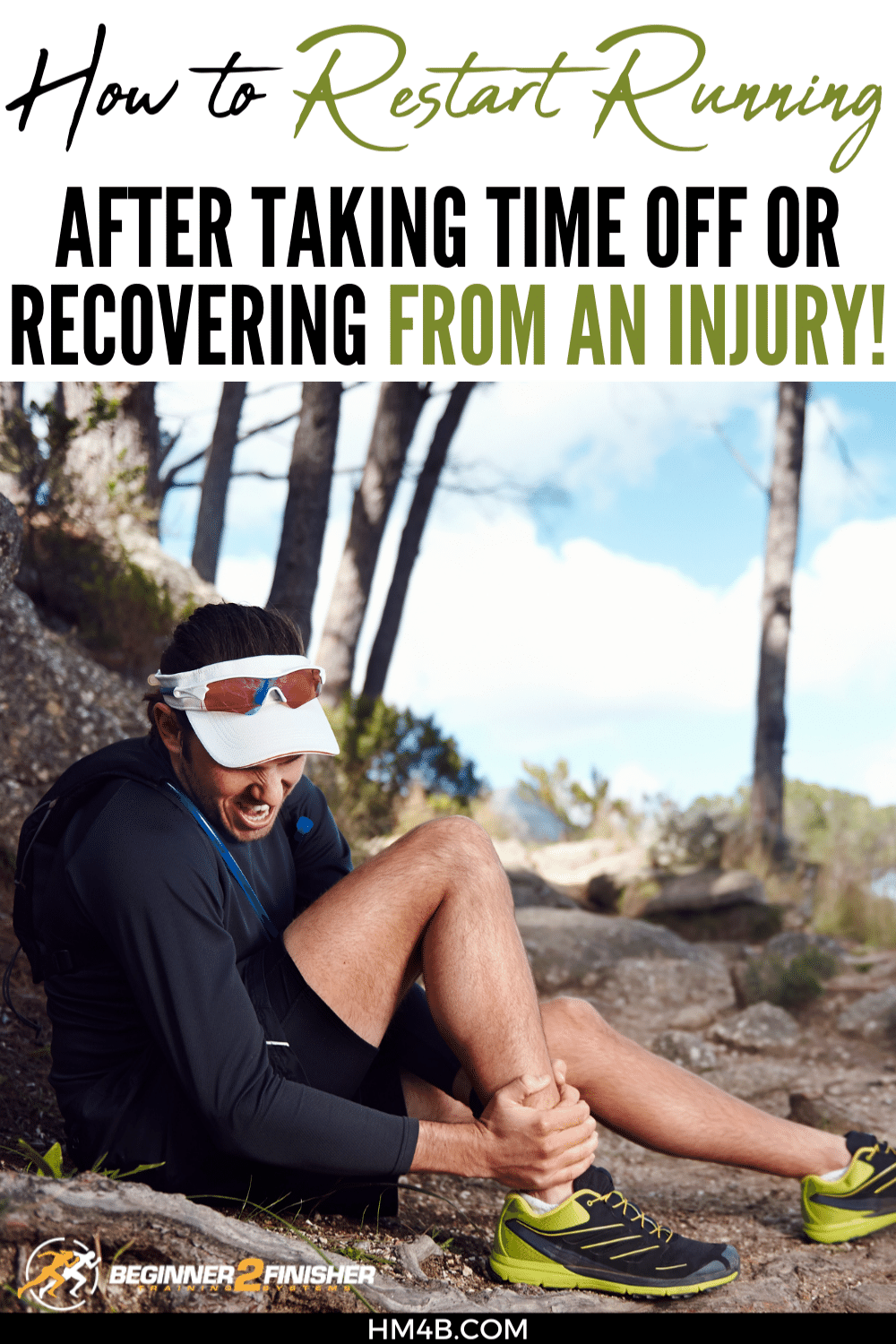
Taking time off and then trying to jump back into running can be a struggle at times. I recently took off 4 weeks from running. I was snowboarding in Japan for 2 weeks and then Angel Fire, NM for the last week. Even though I wasn’t running I was still snowboarding which helped keep my cardiovascular condition in decent shape. There are many different ways to get your running routine back on track, this is the approach I used.
An overall game plan for the week
I planned on logging a total of 10 – 20 miles using a run/walk interval approach. These miles don’t include everyday activities, but dedicated time to run/walking in a park near my house. Also, note that I’m not currently training for any type of race. No race pressure – just simple run/walks throughout the week.
My run/walk intervals were defined as 4 minutes running at a comfortable pace followed by 1 minute walking. During these run/walk sessions I could easily hold a conversation. I wasn’t pushing myself in the least. My goal was to ease myself back into my running.
Some people simply just start running again. No run/walk intervals. Other people might be heavier on the walking side when compared to running. For instance, some runners may choose to walk 4 minutes followed by 1 minute of walking. Another popular run/walk strategy is to run 9 minutes and walk 1 minute. It’s totally up to you to pick how you want to ease back into a solid running routine. Here is a seven-day window of what I did to ease me back into running.
Day 1 – Walk 3+ miles
The first day of the week I usually get back into my work routine and lay off the exercising. My weekends include a long run and an indoor soccer game. If I do any type of exercise on this day it’s either weight lifting or going for a casual walk. Otherwise, it’s a rest day which I use to look at the entire week’s activities.
Day 2: 20 minutes of running. 10 minutes of walking
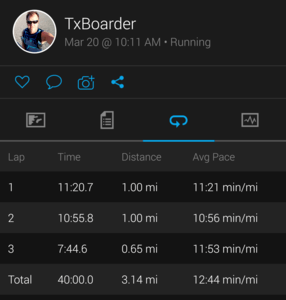
The first typical day that I exercise is Tuesday. I start things off relatively slowly with a simple goal in mind. I only need to run for 20 minutes. Instead of a 20-minute straight run, I choose to implement a run/walk method. I run for 4 minutes and then walk for 1 minute.
The first day I didn’t stretch for that long. Today, I stretched after running for about 5 minutes. For some of you, this will be too easy. For others, this might be too difficult. Change up your intervals of walk/run or just run it. The goal for the week is to ease back into running
Day 3: 30 minutes of running. 10 minutes of walking
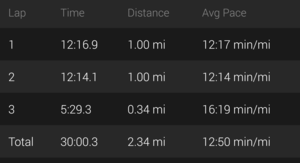
The second day turned out as good as the first day. Legs were in great shape and had no problems at all. In fact, today was easier than the first day. I didn’t push myself past my predetermined goal for the day. Could I have run more? For sure.
Again, for some of you, this will be too easy. For others, this might be too difficult. Change up your intervals of walk/run or just run it.
Day 4: 40 minutes of running. 10 minutes of walking
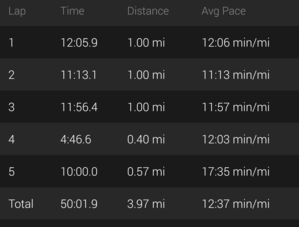
I’m not going to lie to you and tell you everything went great, it didn’t. I was able to finish my 30-minute run. However, during the last 10 minutes of my run, my left outer quad muscle began to start aching slightly. There was no pain, more annoyance than anything, so I was able to power through the run.
In the evening, I grabbed my foam roller and rolled out some of the aches on my outer quads.
Day 5: Cross-train – lift weights
I spent about 30 minutes at the gym working out my Chest, Back, and Biceps. My routine looked something like this:
- Bicep curl – 3 sets of 12-15 reps
- Hammer curl (biceps) – 3 sets of 12-15 reps
- 60-degree Bicep curl – 3 sets of 12-15 rep
- Seated row (back) – 3 sets of 12-15 reps
- Bench press – 3 sets of 12-15 reps
- Incline bench press – 3 sets of 12-15 reps
- Seated chest flys – 3 sets of 12-15 reps
- Wide-grip lat-pulldown (back) – 3 sets of 12-15 reps
- Deadlifts (back) – 3 sets of 12-15 reps
I performed a total of 9 sets in all. 3 exercises per muscle group. On the next weight training day, I will exercise the shoulder, triceps, and leg muscle groups. I didn’t run or walk beside my daily routine activities. I was glad to give my legs a 48-hour break between the next session.
Why do we cross-train if we’re a runner? Remember those things called Glycogen stores? Well building additional muscles in different parts of your body besides your legs helps you have more glycogen store deposits. Also, you use a specific set of muscles when you run so it’s good to use other muscles in your legs to help make your legs more versatile and help prevent injury.
Related: What Is Cross-Training For Runners?
Day 6: 40 minutes of running. 10 minutes of walking
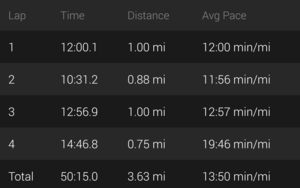
I try to treat my Saturday runs as a long run. My plan for today was to run/walk 60 minutes and walk for 10 minutes as my cooldown. I ended up settling for 40 minutes with 10 minutes of walking. My legs were still a little more sore than usual. After my run, I spent more time than usual stretching out my quads since they were sore.
Day 7: Cross-train – Co-Ed indoor soccer
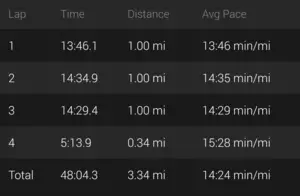
Once a week I play on a co-ed indoor soccer team. Ages 30 and up. A lot of my interval training takes place during my indoor soccer games. Indoor soccer is fast-paced causing you to go from sprinting to walking or light jogging repeatedly throughout a game. I look at indoor soccer as my fartlek (click to read) run for the week due to the randomness of the game.
After the game, I was tired with just a few guy subs we ran a lot. It had been over 4 weeks since I last played soccer. Today was probably the most brutal wake-up call for my legs.
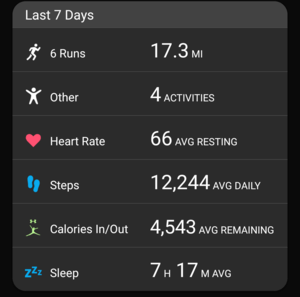
Take Away
The takeaway from this is to listen to your body for aches, pains, being winded, and adjust accordingly. Not everyone is the same and some runners don’t need to ease back into their running, they simply dive right back in. I was glad about what I accomplished, injury-free, and I will start the following week in the same manner but slowly raise my total run times accordingly. Week 3 I should be back to running without using a run/walk interval.
Whatever you do, don’t keep putting off easing yourself back into running. Even if you have to use the above example and do nothing but walk at first, any form of exercise is better than nothing. Until the next time keep running!
If you’re in the middle of a training plan and you have to take a break, please check out this article I wrote:
3 things your half marathon training schedule doesn’t show you
All of the screenshots and logs come from the Garmin Connect App. My fitness tracking device is the Garmin Fenix 6x Pro.
| Help support me and subscribe to my YouTube channel. YouTube video - 30 ways to make your runs less painful! Coach Scott's Credentials:
|
To sign up for a FREE half marathon training schedule, log sheet, and pace predictor CLICK HERE.

Recommended gear for runners
Connect with me:
| facebook.com/BeginnerToFinisher/ |
